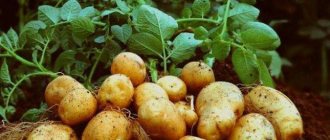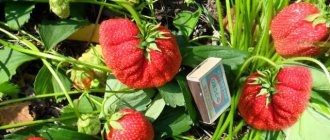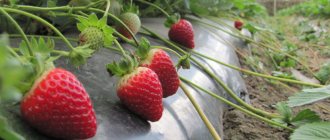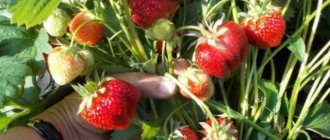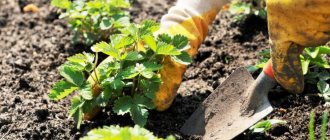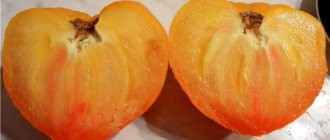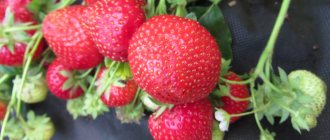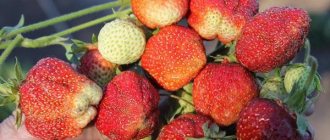Description of the variety “Queen Elizabeth”
The “Queen Elizabeth” variety is very popular among gardeners; let’s take a closer look at its characteristics.
Bushes
Strawberry bushes are large with glossy leaves of light green color. You can see the veins on the leaf.
Flowers and berries
In June, the peduncles are covered with white flowers, and by the end of the month the first fruits appear.
The fruits of this variety are dense and retain their shape when dropped. When ripe, the fruits become round-oblong. The color is bright red with a glossy sheen, as can be seen in the photo below.
With proper care, garden strawberry fruits generally reach 40 g, and in cool summers they can grow up to 100 g. Moreover, they can resemble the size of an apple.
Interesting! The tasting score of ripe berries is 4.3-4.5 points out of 5 possible.
Strawberry yield
The productivity of the variety is high. During the season, you can collect at least 1 kg of berries from one bush. Fruiting requires 8 hours of daylight.
Transportability
Due to their dense structure, the berries are characterized by good transportability, which allows the harvested crop to be transported without damage or loss in quality. The berries are well stored without loss of appearance and quality characteristics.
Strawberry "Queen Elizabeth 2" - description, photo
A new remontant variety was bred by Don breeders and quickly became popular among gardeners and gardeners. He differs from the first Elizabeth:
- larger fruits;
- a large number of mustaches;
- more pronounced repairability;
- better yield.
The honey taste of the fruit has a slight sourness, which emphasizes the sweetness of the berries and enriches their flavor bouquet. From one bush you can collect more than one and a half kilograms of berries per season. Placed on one square meter from 4 to 6 bushes, with good and proper care over the summer they will yield up to 12 kg of harvest.
Flaws
- low percentage of germination (50-60%);
- complex process of reproduction;
- low yield of young plants.
Find out also about other varieties of garden strawberries on our website: “Clery”, “Honey”, “Lord”, “Maxim”, “Asia”.
Harvest and storage
Queen Elizabeth garden strawberries are collected, without allowing them to overripe, in small containers of small volume. When transportation is planned, the berries are removed 3–4 days before final ripeness.
The Queen Elizabeth garden strawberry harvest is a spectacle that will delight any summer resident
Berries are picked only from completely dry bushes, separating them along with the stalks. Damaged garden strawberries are immediately stored separately. It is not recommended to pour and sort it later.
The variety is versatile. In addition to eating fresh, the berries are used as a filling for all kinds of baked goods and home canning. Since the pulp is quite dense, Queen Elizabeth does not boil down in jam or compote.
Due to the fact that the berries are very dense, Queen Elizabeth jam is not only tasty, but also aesthetically pleasing.
At room temperature, the berries, if they are not exposed to sunlight, will last for 3–4 days. In the refrigerator, in plastic containers with a tight-fitting lid, in a compartment designed to accommodate vegetables and fruits, Queen Elizabeth will last 1.5 weeks or a little more without damage. You cannot use plastic bags, even with zippers - the taste noticeably deteriorates. You can’t wash the berries either.
The strawberries are first cooled to a temperature just above 0ºС. The sooner this happens after removal from the bush, the better.
Only frozen berries can be preserved for a long time. Queen Elizabeth tolerates this procedure well, without losing its shape, taste and benefits, but it takes up a lot of space in the freezer. Frozen strawberry puree with sugar (1:1), citric acid or without any additives looks more compact. This product will last 10–12 months.
Freezing allows you to maximize the shelf life of garden strawberries
Planting and propagation
There are several ways to propagate this variety. This can be planting using seeds, using tendrils and other methods. Let's briefly look at each of them.
Planting by seeds
The technology for growing strawberries from seeds can be represented as follows:
It is best to start planting seeds in late February - early March. If it is possible to provide additional lighting at the place where the seeds grow, then it is possible to plant at the end of January;
- for planting you will need a container about 12 cm high. It is filled with soil and moistened with water;
- Next, the seeds are laid out on the surface of the soil and distributed evenly over it. It should be remembered that they need to be lightly pressed onto the soil. They should not be deeply buried in the ground, since strawberry seeds can only germinate in the light;
- at the next stage, the container is covered with a glass cap or plastic film. Next, the container is placed on the bright side of the window sill;
- Next, it is necessary to provide access to fresh air under the glass cap or film. To do this, you need to raise either one or the other for 10 minutes every day;
- It is also necessary to control soil moisture. It is better to use a spray bottle;
- After 14-18 days, the first shoots should appear. After this, it is necessary to increase the ventilation time daily to 30 minutes. The germination percentage is low. 50-60% of seeds germinate;
- after the appearance of the second leaf on the seedlings, the plants must be planted in separate containers (cups);
- Young seedlings must be watered very carefully and carefully monitor soil moisture. Excess moisture can lead to negative consequences. In particular, the rosette of the plant may turn black, which will ultimately lead to the death of the plant;
- Also, special attention should be paid to lighting. If there is not enough daylight in the room, then it is necessary to take care of an additional light source;
- After 120 days after germination, you can transplant them to the garden bed. But for this, the seedlings need to be gradually prepared. It is necessary to take them outside for a few minutes every day and then return them to their place.
Landing with a mustache
Most often, Queen Elizabeth strawberries are propagated using runners.
Planting using this method can be carried out both in spring and autumn. Often, experienced gardeners prefer the second half of summer, when the rosettes are sufficiently strong. In most cases, this will improve the yield of new plants the following year.
There is no need to leave a whole bed for this. It is enough to leave one bush - and in the end you will get about 10 tendrils if you take good care of the plant. Therefore, the optimal number of bushes for seedlings will be 5-6 per bed. For seedlings, it is better to choose healthy, high-yielding plants that have produced crops for 2 years.
Tendrils appear on the plant during the strawberry flowering period and their number increases after harvest.
Other methods of reproduction
Other methods of propagating Queen Elizabeth strawberries include dividing the bushes.
The strongest and most fruitful mother bushes are suitable for this method of propagation. Their age should be about 2-3 years.
Important! It is better to choose sprouts that are closest to the main bush, as they are the strongest and contribute to rapid rooting.
To divide the bush, plants are selected that are 2-3 years old with a well-developed root system. It is better to separate them in spring or autumn.
For these purposes, the bush must first be dug up. Next, it is divided in half and transplanted into pre-prepared holes. In this case, it is necessary to ensure that each separated bush has its own rosette with leaves.
However, it should be remembered that the main characteristics of the variety are often not transmitted to the bushes, so this method of propagation is extremely rare in practice.
Photos and features of the variety
Strawberries "Queen Elizabeth" can produce an impressive harvest in almost any soil. This variety of strawberry is different:
- fruit weighing 50–65 grams;
- dark scarlet juicy, dense berries with a shiny surface;
- spreading powerful bushes;
- light honey taste of fully ripened fruits;
- early pregnancy;
- long shelf life;
- cold resistance;
- high productivity.
An important feature of the variety is its remontability. This means that Victoria 'Queen Elizabeth' bears fruit three times during the summer. Already at the end of May you can pick the first berries . At the beginning of July, the second stage of fruiting begins. The third time fruits appear on the bushes is at the end of August. You can pick strawberries until frost. The bushes are decorated with flowers all season long, making them an excellent decorative element of the garden plot.
Caring for strawberries “Elizabeth”
To obtain a good harvest, a big role is given to proper plant care. To do this, it is necessary that you know how to water the plant, what feeding is needed, what fertilizers are required, and how to replant the bushes.
Watering
When watering, you must remember that this plant is sensitive to moisture. That is, the plant does not tolerate waterlogging.
However, regular watering will help ensure a good harvest.
It is best to carry it out using the drip method, which will increase the yield of strawberries. To maintain moisture in the soil, it is necessary to frequently and thoroughly loosen the soil near the rhizome.
If you take a lump of earth from a garden bed in your hand and, having squeezed it tightly, you get a lump, then you should wait to water it, but if the earth crumbles, then there is not enough moisture in the soil. Drooping leaves of the plant can also indicate a lack of moisture.
In dry weather, watering is best done every 2-3 days. In this case, the water taken is not very cold.
Important! When watering, you must also carefully ensure that droplets of moisture do not fall on the flowers and strawberry fruits.
Transplanting garden strawberries
It must be remembered that this plant is replanted after a year , since the yield directly depends on how long the bush spent in the garden. The rule here is: the longer the plant was in the garden, the greater the yield you can get next year.
Fertilizer and feeding
Since the plant belongs to a repair variety, it becomes very depleted over the season and needs regular feeding.
The optimal frequency of feeding is 7-10 days. The first feeding is carried out a week after planting the plant in the ground. It is better to use organic fertilizers as regular feeding.
For watering, an infusion of manure or bird droppings is suitable; infusions of nettle leaves or other greens after fermentation are suitable. In order to prepare this fertilizer, it is necessary to add double the volume of water to the starting material. Cover it all tightly and put it in a warm place. You can tell that the fertilizing is ready when a strong unpleasant odor appears. After which the resulting product is diluted in a ratio of 1 to 15 if chicken manure was used, and 1 to 10 for the remaining ingredients.
Advice! To treat strawberry bushes, the best option would be to use an infusion of wood ash.
Before the first harvest is harvested, only foliar feeding is required. To do this, with the appearance of leaf buds, it is necessary to spray the bushes. Then the same manipulations are carried out with flowers and berries. The main emphasis should be on the inside of the sheet.
You can also use the following as a top dressing:
- solutions that are prepared in accordance with the manufacturer's instructions, such as Plantafol, Agros, Gera and others;
- fertilizers containing nitrogen;
- a mixture of potassium nitrate, potassium permanganate and boric acid with water;
- a solution made from pressed or powdered yeast;
- whey or kefir, diluted in water.
After the crop is harvested, fertilizer granules containing phosphorus and potassium must be scattered on the garden bed. This can be fertilizers of this type such as Autumn, Nitrophoska, wood ash.
Secrets of growing Queen Elizabeth strawberries
Since strawberries of this variety are very unpretentious, they can grow on almost any soil. But to get a good harvest and large, juicy fruits, you will need to follow some rules for planting and growing it.
Strawberries will generously thank you for their fruiting if you plant them in a well-lit place, in fertile loamy neutral soil. Excessive watering and shade have a negative impact on the crop.
The basic rules for planting the Queen Elizabeth variety include:
- You can plant bushes in a permanent place throughout the entire planting season. Experienced gardeners recommend doing this at the end of July or beginning of August.
- A kut planted in spring will bear fruit well next year if the buds that appear on it are cut off.
- It is recommended to plant strawberries in beds where cucumbers, carrots, onions or garlic grew last year.
- Strawberry bushes should be spaced 25 cm apart from each other. The distance between rows should be from 55 to 70 cm.
- For strawberries planted in the spring, potassium and nitrogen-containing mineral fertilizers are added to the soil. About 20 grams per hole. In autumn, it is enough to enrich the soil only with potassium. This is explained by the fact that nitrogen fertilizers promote the growth of green mass, which is completely unnecessary before the onset of cold weather.
- Before placing the bush in the prepared hole, you need to cut the roots to 7 cm in length and dip them in a mixture of manure and clay.
- The hole for planting should be approximately 20 cm deep. The bush is placed in it and covered with soil so that the main bud is 2 cm higher above the ground.
- The planted plants are well watered with warm water, after which the soil is leveled and gently pressed down. The Victoria bush should sit tightly in the ground.
To ensure good soil breathability and facilitate further maintenance, it is recommended to mulch the soil around the Victoria with straw, freshly cut grass, rotted sawdust or straw.
Diseases and pests
Many agronomists claim that strawberries are a resilient plant and can easily grow in rather difficult climatic conditions.
But it should be remembered that it is subject to pest invasion and is susceptible to diseases:
- spider mite The main signs of its appearance include the formation of beige-brown spots on the leaves. Treatment includes sprinkling the bushes with a decoction of onion peels. You can also wash the bushes with a soapy solution. It is imperative to remove all affected leaves;
- strawberry weevil. It causes the buds to turn black, which then wither and fall off. To destroy it, an infusion of tobacco, mustard or pepper in combination with soap is suitable. Collection and destruction of already damaged foliage;
- strawberry nematode. Causes deformed foliage that is easy to break. At the same time, the strawberry fruits also become uneven and small. The rhizome is distinguished by white swellings. To eradicate the problem, it is best to plant calendula or marigolds in the neighborhood. Fumigation with a sulfur bomb may help;
- slugs Their appearance is also accompanied by the formation of holes in the berries. As control measures, we can recommend constant mulching of the earth with pine needles, ash or eggshells;
- gray rot. The main symptom of its appearance is a gray coating on the leaves, which is also characterized by black spots. To destroy it, you can use a dusting of ash.
Strawberries or garden strawberries?
The vast majority of gardeners are sincerely mistaken when they are confident that they are growing strawberries on their own plot. The large, bright red, aromatic berries familiar to everyone are actually garden strawberries. These plants belong to the same Rosaceae family, but have several significant differences.
Real strawberries are known to botanists as “nutmeg” or “musk” strawberries. It ripens significantly earlier than its “relative”, in the second ten days of June. Strawberries are quite small, almost spherical, with a pointed tip and a noticeable purple tint. It also has a strong aroma.
Real strawberries are almost never found in garden plots, and there are objective reasons for this
Another feature that reduces the value of strawberries for gardeners to almost zero is that this plant is bisexual; it has “male” and “female” flowers. The former act only as pollinators; the berries do not ripen on them and there are significantly more of them.
Garden strawberries (or pineapple strawberries) do not have wild “ancestors”; they are a hybrid obtained as a result of cross-pollination of Chilean and Virginia strawberry seedlings. Its berries are significantly larger than those of strawberries, and the pulp is much sweeter and juicier. Productivity cannot be compared at all.
Unlike strawberries, which “hide” in the shade and love wet lowlands, garden strawberries prefer open, well-warmed areas by the sun. Its bushes are more compact, not so powerful and spreading, the leaves are darker, not so corrugated. Real strawberries are more cold-resistant, but tolerate heat less well.
But for a gardener, these botanical subtleties are, in essence, not so important. For him, the main thing is the yield and taste of the berries. Therefore, when planting garden strawberries, they stubbornly continue to call them strawberries - this is much shorter and everyone understands what you mean.
Description of strawberry and its origin
Elizabeth 2 grows safely in the southern and central regions of Russia. This variety was bred in 2001 at the Don Nursery. Having successfully tested in different climatic zones, the variety confirmed its adaptation to the changeable climate of the middle zone. The variety is not afraid of winter temperatures, spring frosts and prolonged rains - everything that usually interferes with the normal fruiting of garden strawberries in a temperate climate.
Brief botanical description of the Elizabeth 2 variety:
- Bushes. Powerful and spreading, well leafed.
- Leaves. Large, shiny edges are ribbed. They protect fruits well from precipitation and contamination. The color of the leaves is rich – emerald green.
- Flowers. White, core – bright yellow.
- Fruit. Dense, “varnished”. Large, weighing 40-50 g. With skillful agricultural technology, larger berries are obtained - 60-65 g. Some record-breaking specimens reach 100 g. Color - bright red. The shape is a tuberous cone. The taste is sweet, dessert, the aroma has honey notes. The seeds are beige in color, planted deep.

